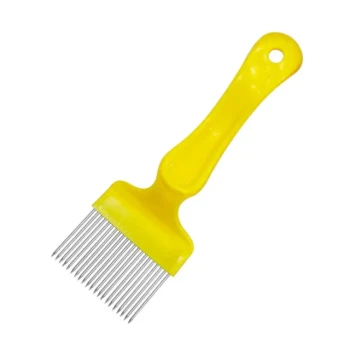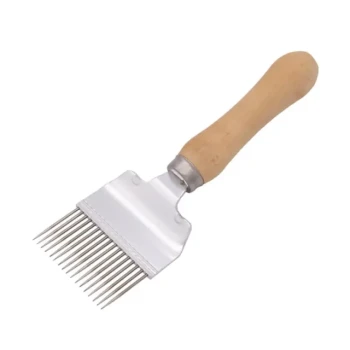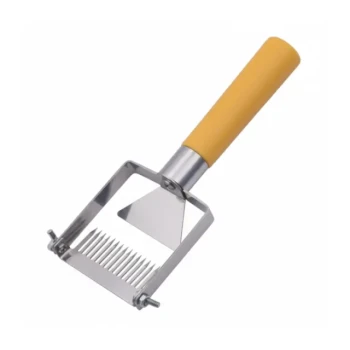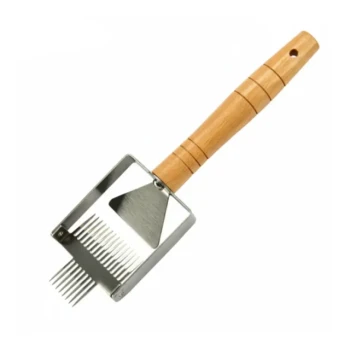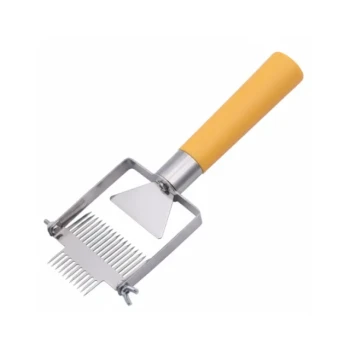An uncapping fork works by manually sliding its sharp tines beneath the wax caps of sealed honeycomb and lifting them off. Its primary benefits are its precision in handling uneven comb, its low cost, and its simple, non-electric operation, making it a foundational tool for many beekeepers.
The uncapping fork's true value is not speed, but control. It allows a beekeeper to meticulously unseal honey cells with minimal waste, especially on imperfect frames where other tools would fail.

The Mechanics of Uncapping
An uncapping fork is a simple but highly effective manual tool. Its design allows for a more delicate approach compared to other uncapping methods.
How It Lifts the Wax
The process involves pushing the fork's metal tines just under the layer of wax capping. With a slight prying or lifting motion, the beekeeper can peel back sections of capping, exposing the honey-filled cells beneath.
This action is repeated across the entire frame surface until all sealed cells are open and ready for honey extraction.
The "Scratching" Technique
Beyond pre-extraction, a fork has a secondary use inside the hive. A beekeeper can use it to lightly scratch the surface of capped honey frames they want the bees to consume or relocate.
This signals to the bees that the stores are "leaking," encouraging them to move the honey, often to make space for the queen to lay eggs or to consolidate resources.
Key Advantages Over Other Tools
While electric knives or rollers may offer speed, the fork provides unique benefits that make it indispensable in certain situations.
Superior Precision on Uneven Combs
Frames are not always perfectly flat. A fork excels at reaching honey in low spots, corners, or on cross-combed sections where a flat uncapping knife would simply glide over the top.
Minimal Honey Loss
Because the fork lifts the cappings away cleanly, very little honey is left attached to the wax. This contrasts with piercing tools like rollers, which can leave honey in the cells and make the cappings more difficult to process.
Cost-Effective and Simple
As a non-electric, simple piece of metal, the uncapping fork is one of the most budget-friendly tools in beekeeping. It requires no power, is easy to clean, and has virtually no maintenance.
Understanding the Trade-offs
No tool is perfect for every situation. Objectivity requires understanding the fork's limitations.
The Primary Drawback: Speed
The main trade-off for the fork's precision is speed. Uncapping a frame with a fork is significantly more time-consuming than using an electric knife. For commercial operations with hundreds of frames, it is not a primary tool.
Fork vs. Roller: A Key Distinction
An uncapping roller pierces the cappings with small pins rather than removing them. This is very fast and leaves the wax structure on the frame, meaning the bees have less wax to rebuild.
However, piercing can be less thorough, potentially leaving some cells sealed. The fork ensures every cell is open, leading to a more complete extraction, but requires the bees to expend more energy rebuilding the wax.
Making the Right Choice for Your Apiary
Selecting the right tool depends entirely on the scale of your operation and the condition of your frames.
- If you are a hobbyist with a few hives: The uncapping fork is the most practical and economical choice for your primary tool.
- If you frequently harvest from imperfect or warped frames: The fork's precision is non-negotiable for effectively reaching honey in recessed areas.
- If your priority is processing many frames quickly: Start with an electric knife or roller, but always keep an uncapping fork on hand for cleanup and difficult spots.
Choosing the right uncapping tool is about matching your equipment to your specific goals and beekeeping style.
Summary Table:
| Aspect | Details |
|---|---|
| Primary Function | Manually lifts wax cappings from sealed honeycomb cells. |
| Key Benefits | Superior precision on uneven frames; Minimal honey loss; Low cost and simple operation. |
| Best For | Hobbyists, frames with warped or cross-combed sections. |
| Main Trade-off | Slower than electric knives or rollers for large-scale operations. |
Maximize your honey harvest with the right tools.
For commercial apiaries and beekeeping equipment distributors, choosing the correct uncapping equipment is critical for efficiency and honey yield. HONESTBEE supplies a full range of durable, high-performance beekeeping supplies and equipment, including uncapping forks, knives, and rollers, tailored for wholesale operations.
Let our experts help you select the perfect tools to match your scale and frame conditions. Contact HONESTBEE today to discuss your equipment needs and boost your productivity.
Visual Guide

Related Products
- Professional Customizable Honey Uncapping Fork with Adjustable Tine Options
- Professional Honey Uncapping Fork Tool with Customizable Tine Options
- Professional Classic Wood Handle Honey Uncapping Fork
- Adjustable Stainless Steel Honey Uncapping Fork with Plastic Handle for Beekeeping
- Double-Sided Pivoting Honey Uncapping Fork with Scraper for Beekeeping
People Also Ask
- What is an uncapping knife? Choose the Right Tool for Your Beekeeping Scale
- How does a cold knife assist in the uncapping process? Master Efficient Honey Harvesting
- What is the use of a bee knife? Essential for Efficient Honey Harvesting
- What temperature should a honey knife be? The Key to Clean, Fast Uncapping
- What is the benefit of the serrated edge on an uncapping knife? Unlock Faster, Cleaner Honey Extraction
